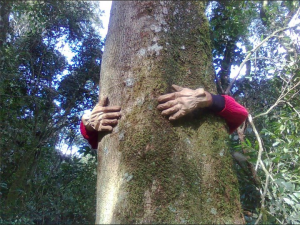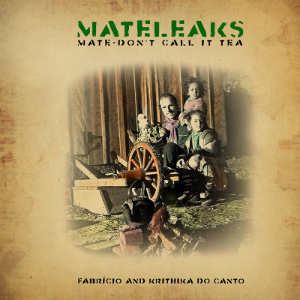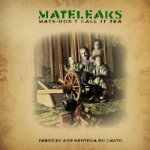Correcting yerba-mate, erva-mate, or mate tea, attempts to educate mate drinkers about an important mistake in its linguistic history.
The name yerba-mate is a neologism coined centuries ago by combining the Spanish word yerba (herb) with the Quechua mate (vessel). While the second was an accurate description of a word including diverse usage from the indigenous vocabulary, the first illustrates a colonial mistake
The error is that the Ilex paraguariensis A. St.-Hil is a tree not a herb.

Trunk of a Illex Paraguariensis Tree
According to Wikipedia : Herbaceous plants (in botanical use frequently simply herbs) are plants that have no persistent woody stem above ground.[1]
The words yerba, tea, or the Portuguese terms erva or cha did help popularize consumption both in South America and abroad, however, this also diverted from the native origins.
The indigenous words used for the plant, the Guarani Caá (forest) or Tupí Congonha (nourishment), make the usage of yerba a generic but inadequate translation. Javier Ricca, Uruguayan author and scholar of mate culture refers to this mistake in his book “El Mate, history and Secrets”.
According to Ricca, the root of this mistake was that the European always got the leaves delivered and never went to the forest to see the tree, so they by mistake called it a herb, though it is a tree.”
By using the term yerba mate it was easy understood and sold. A similar generalization was the term Paraguayan or Jesuit Tea. Also the use of the word tea for Ilex paraguariensis is a mistake since it does not refer to the tea plant (Camellia Sinensis).
Many Mate vendors use the term tea in the scope of educating the general public. This was stated in the title of the book Mateleaks: Mate – Don´t call it Tea. This lose terminology using tea or yerba makes an easier introduction of a new product in a known category, but the generalization excludes unique qualities. Unlike other cash crops or commodities, this plant was not domesticated and cultivated but grew wild in the forest, and more than that it was used in a ritualistic way. This usage was seen as uncivilized thus not favorable to be promoted. The colonizers used the generic words “Yerba” or ‘tea’ to support the trade and assimilation of this plant inside their cultural frame work. While tea is often used as a synonym for any infustion, herb is also generically used for any food, flavoring, medicine or fragance with “plant ” and healing properties. While generalizations help the new bees to first have an idea about a subject, we prefer to advance with precision to promote a deep understanding of Mate.
The indigenous Guarani term used for the plant Cáa , forest, reenforces its origins, and differentiates it from a plant that was cultivated and valued for trade by the colonizers.
With the expansion of colonialism, the free access to the forest for the indigenous was shifted towards the specialized work of cultivating in monocultures overseen in part by the Jesuits, who were there at the time to educate and civilize the tribes. Labor conditions were unclear at the time and reports vary. Slave-like life standards are described in Alfredo Varela’s novel, o Rio Escuro (Der Mate Pflucker – in German) or the documentary “I Like mate withour Child Labour “ shows current conditions of yerba mate laborers in Argentina. These developments are usual results in the exploitation of a colonization era. Now to understand and revert its practices is a decolonizing attitude we want to support in an act of true education.
Time has shown a name shifting from a expression of devotion towards the church, the Jesuit Tea, to a more commercial Yerba, and even lately to a nationalistic claim of Yerba Mate from Argentina. Eventually this developed into the submission to ruling structures of the free market.
The naming and producing of yerba favored the trade and supported the shift from the wild harvests and small productions into cultivated monoculture with standard mass production as the ideal model for the food supply of urban settlements.
500 years after colonization with increasing deforestation it is worth to consider the forest origins of the Guarani culture their valorization of mate as more than a drink. It is a way to integrate life in a ritual, connecting to nature; it is a timeless encounter between people and plants, ancestors and descendants. It is a way to learn from the past, plan the future and stay in the present.
Materos, when drinking may reflect on precision in terms of the names yerba mate or erva mate, and further research the culture of harvesting, producing and consuming the plant. Mate Entrepreneurs such as Club Mate, KolleMate, MunterMate, Sollimate, all drinks that do not use the word yerba or tea to promote their spin-offs, add the nuances of their product with qualities describing the personality of their drink. The term Meta Mate, alludes to the unifying aspects of this drink as the cup of compassion, connection with nature and rejuvenation as integrated in indigenous lifestyles.



Yerba mate should be classified as an herb as it has lots of minerals, vitamins, and the leaves and stems of the tree in the holly family are used.
Very informative & looking forward to watching the documentary mentioned above. Thanks for sharing.
Thank you for the essential understanding of what we’ve been drinking for years…